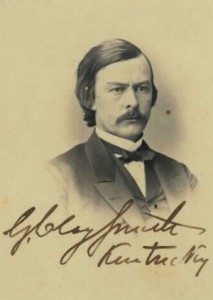
Green Clay Smith
Early Kentucky Baptist Minister, Soldier and Lawyer

Green Clay Smith was the son of John Speed Smith, served as a Representative from Kentucky; He was born in Richmond, Madison County, Ky., July 4, 1826; pursued academic studies; served in the Mexican War; commissioned second lieutenant in the First Regiment, Kentucky Volunteer Infantry, June 9, 1846; was graduated from Transylvania University, Lexington, Ky., in 1849; studied law; was admitted to the bar in 1852 and commenced practice in Covington, Ky.; was school commissioner 1853-1857; member of the State house of representatives 1861-1863; commissioned colonel of the Fourth Regiment, Kentucky Volunteer Cavalry, April 4, 1862; brigadier general of Volunteers July 2, 1862; resigned December 1, 1863; brevetted major general of Volunteers March 13, 1865; elected as an Unconditional Unionist to the Thirty-eighth and Thirty-ninth Congresses and served from March 4, 1863, until his resignation in 1866; chairman, Committee on Militia (Thirty-ninth Congress); appointed by President Johnson as Governor of Montana Territory and served from July 13, 1866, until April 9, 1869, when he resigned; He was ordained to the ministry by the Viney Fork church and served various churches in the Madison county area. He served as Moderator of the Tates Creek Association for the 1871 and 1872 sessions. He later accepted the pastorate of Frankfort First Baptist Church and served as Moderator of the General Association of Baptists in Kentucky from 1879 through 1887. He was the candidate of the National Prohibition Party in 1876 for President of the United States; Following his tenure as Pastor of Frankfort First Baptist, he moved to become pastor of the Metropolitan Baptist Church in Washington, D.C., from 1890 until his death, June 29, 1895; He is interred in Arlington National Cemetery.[H. Levin, editor, Lawyers and Lawmakers of Kentucky, 1897; reprint, p. 530.
____________
Smith served as Pastor of Richmond, First; Tates Creek and possibly others in the Tates Creek Association. According to their history, Glens Creek Baptist was also one of his pastorates. It is also possible that he served churches in the South Central area of Kentucky.Cumberland College mentions him in their on-line history, saying,
A few short decades after the Civil War, there gathered in September of the year 1887 in a little weather-beaten country church in the mountains of Eastern Kentucky a few men representing eighteen Baptist Churches. It was the annual meeting of the Mount Zion Association in a region having only one or two small schools that offered as much as a high school education.Though these few men had only a meager common school education themselves, and some scarcely that, they, nevertheless, felt the responsibility of providing some means of higher education for the children of the Kentucky mountains.
The Association minutes show the founders were poor - $366 was the total amount contributed by their eighteen churches during the year 1887-1888 to pastors' salaries . They, nonetheless, solemnly passed a resolution, through the encouragement of General Green Clay Smith and under the leadership of R. C. Medaris, looking toward the founding of a College then called Williamsburg Institute. The articles of Incorporation were approved by the State Legislature in April 6, 1888, although the doors did not open until January 7, 1889, the date from which the college celebrates its founding.
============== [The above information was supplied by D. L. Brewer, Richmond, Kentucky. Scanned and formatted by Jim Duvall.]
More Baptist Bios
Baptist History Homepage